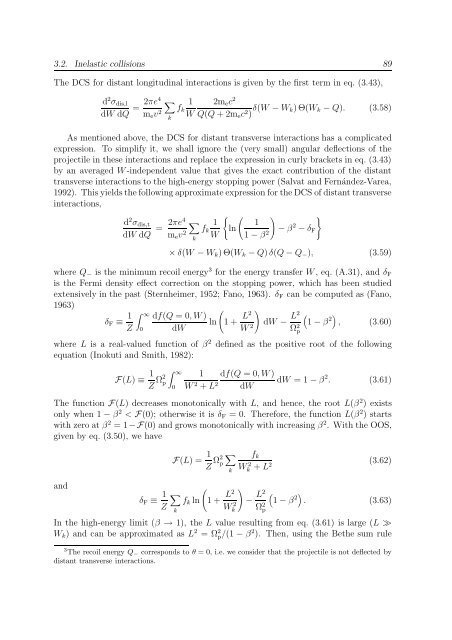PENELOPE 2003 - OECD Nuclear Energy Agency
PENELOPE 2003 - OECD Nuclear Energy Agency
PENELOPE 2003 - OECD Nuclear Energy Agency
You also want an ePaper? Increase the reach of your titles
YUMPU automatically turns print PDFs into web optimized ePapers that Google loves.
3.2. Inelastic collisions 89<br />
The DCS for distant longitudinal interactions is given by the first term in eq. (3.43),<br />
d 2 σ dis,l<br />
dW dQ = 2πe4<br />
m e v 2 ∑<br />
k<br />
f k<br />
1<br />
W<br />
2m e c 2<br />
Q(Q + 2m e c 2 ) δ(W − W k) Θ(W k − Q). (3.58)<br />
As mentioned above, the DCS for distant transverse interactions has a complicated<br />
expression. To simplify it, we shall ignore the (very small) angular deflections of the<br />
projectile in these interactions and replace the expression in curly brackets in eq. (3.43)<br />
by an averaged W -independent value that gives the exact contribution of the distant<br />
transverse interactions to the high-energy stopping power (Salvat and Fernández-Varea,<br />
1992). This yields the following approximate expression for the DCS of distant transverse<br />
interactions,<br />
d 2 σ dis,t<br />
dW dQ = 2πe4<br />
m e v 2 ∑<br />
k<br />
f k<br />
1<br />
W<br />
{<br />
ln<br />
(<br />
1<br />
1 − β 2 )<br />
− β 2 − δ F<br />
}<br />
× δ(W − W k ) Θ(W k − Q) δ(Q − Q − ), (3.59)<br />
where Q − is the minimum recoil energy 3 for the energy transfer W , eq. (A.31), and δ F<br />
is the Fermi density effect correction on the stopping power, which has been studied<br />
extensively in the past (Sternheimer, 1952; Fano, 1963). δ F can be computed as (Fano,<br />
1963)<br />
δ F ≡ 1 Z<br />
∫ ∞<br />
0<br />
df(Q = 0, W )<br />
dW<br />
ln<br />
(<br />
1 + L2<br />
W 2 )<br />
dW − L2<br />
Ω 2 p<br />
(<br />
1 − β<br />
2 ) , (3.60)<br />
where L is a real-valued function of β 2 defined as the positive root of the following<br />
equation (Inokuti and Smith, 1982):<br />
F(L) ≡ 1 Z Ω2 p<br />
∫ ∞<br />
0<br />
1 df(Q = 0, W )<br />
dW = 1 − β 2 . (3.61)<br />
W 2 + L 2 dW<br />
The function F(L) decreases monotonically with L, and hence, the root L(β 2 ) exists<br />
only when 1 − β 2 < F(0); otherwise it is δ F = 0. Therefore, the function L(β 2 ) starts<br />
with zero at β 2 = 1−F(0) and grows monotonically with increasing β 2 . With the OOS,<br />
given by eq. (3.50), we have<br />
and<br />
F(L) = 1 Z Ω2 p<br />
∑<br />
δ F ≡ 1 ( )<br />
∑<br />
f k ln 1 + L2<br />
Z<br />
k<br />
Wk<br />
2<br />
k<br />
f k<br />
W 2 k + L 2 (3.62)<br />
− L2 ( ) 1 − β<br />
2<br />
. (3.63)<br />
Ω 2 p<br />
In the high-energy limit (β → 1), the L value resulting from eq. (3.61) is large (L ≫<br />
W k ) and can be approximated as L 2 = Ω 2 p/(1 − β 2 ). Then, using the Bethe sum rule<br />
3 The recoil energy Q − corresponds to θ = 0, i.e. we consider that the projectile is not deflected by<br />
distant transverse interactions.
















